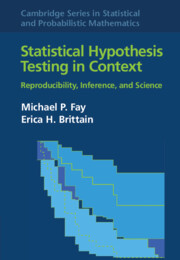Book contents
- Frontmatter
- Contents
- Preface
- 1 Introduction
- 2 Theory of Tests, p-Values, and Confidence Intervals
- 3 From Scientific Theory to Statistical Hypothesis Test
- 4 One-Sample Studies with Binary Responses
- 5 One-Sample Studies with Ordinal or Numeric Responses
- 6 Paired Data
- 7 Two-Sample Studies with Binary Responses
- 8 Assumptions and Hypothesis Tests
- 9 Two-Sample Studies with Ordinal or Numeric Responses
- 10 General Methods for Frequentist Inferences
- 11 k-Sample Studies and Trend Tests
- 12 Clustering and Stratification
- 13 Multiplicity in Testing
- 14 Testing from Models
- 15 Causality
- 16 Censoring
- 17 Missing Data
- 18 Group Sequential and Related Adaptive Methods
- 19 Testing Fit, Equivalence, and Noninferiority
- 20 Power and Sample Size
- 21 Bayesian Hypothesis Testing
- References
- Notation Index
- Concept Index
11 - k-Sample Studies and Trend Tests
Published online by Cambridge University Press: 17 April 2022
- Frontmatter
- Contents
- Preface
- 1 Introduction
- 2 Theory of Tests, p-Values, and Confidence Intervals
- 3 From Scientific Theory to Statistical Hypothesis Test
- 4 One-Sample Studies with Binary Responses
- 5 One-Sample Studies with Ordinal or Numeric Responses
- 6 Paired Data
- 7 Two-Sample Studies with Binary Responses
- 8 Assumptions and Hypothesis Tests
- 9 Two-Sample Studies with Ordinal or Numeric Responses
- 10 General Methods for Frequentist Inferences
- 11 k-Sample Studies and Trend Tests
- 12 Clustering and Stratification
- 13 Multiplicity in Testing
- 14 Testing from Models
- 15 Causality
- 16 Censoring
- 17 Missing Data
- 18 Group Sequential and Related Adaptive Methods
- 19 Testing Fit, Equivalence, and Noninferiority
- 20 Power and Sample Size
- 21 Bayesian Hypothesis Testing
- References
- Notation Index
- Concept Index
Summary
This chapter deals with studies with k groups.When the k groups are unordered, we use k-sample tests, and when the k groups are ordered, we use trend tests.For k-sample tests with categorical responses, we describe the chi-squared test and Fisher’s exact test (also called the Freeman–Halton test). For k-sample tests with numeric responses, we cover one-way ANOVA, studentized range test, and the Kruskal–Wallis test. For the one-way ANOVA and studentized range tests, we give some associated effect parameters and their confidence intervals. For trends tests, we describe the Cochran–Armitage trend test for binary responses, and the Jonckheere–Terpstra test for numeric responses. We discuss familywise error rate when performing follow-up tests of pairwise comparisons in the k-sample studies. When k = 3, after rejecting the k-sample test, then subsequent pairwise tests may be done without correction, but otherwise (k > 3) corrections are necessary for strongly controlling the Type I error rate (e.g., for all pairwise comparisons: Tukey–Kramer, Tukey–Welch, and studentized range procedures, or for many-to-one comparisons: Dunnett’s procedure).
- Type
- Chapter
- Information
- Statistical Hypothesis Testing in ContextReproducibility, Inference, and Science, pp. 195 - 214Publisher: Cambridge University PressPrint publication year: 2022



